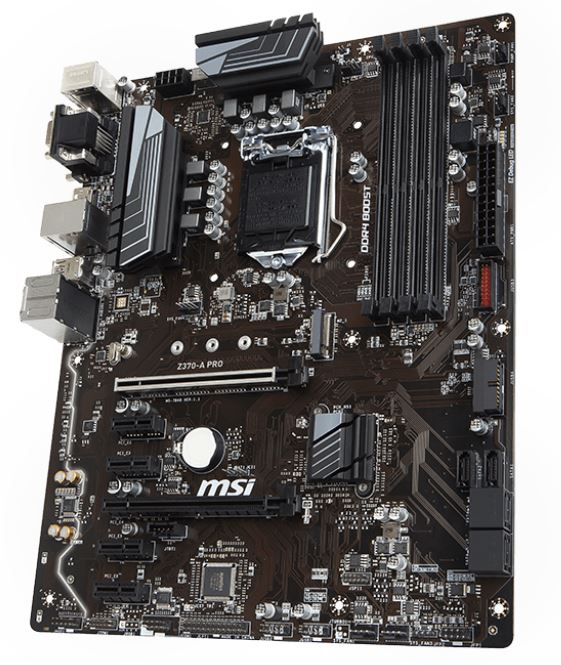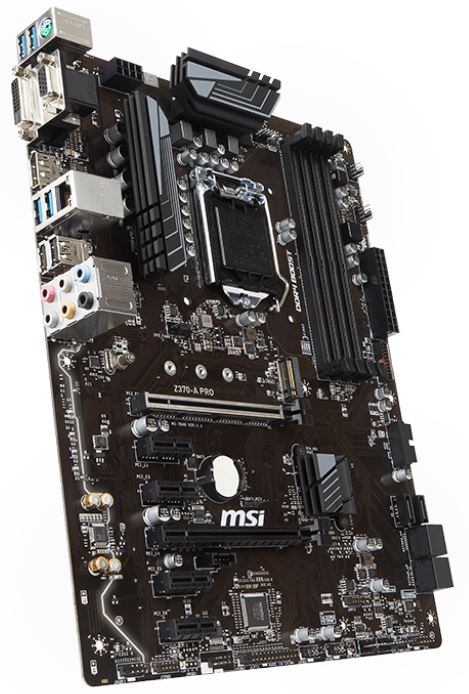The MSI Z370-A Pro Motherboard Review: Entry Level Business (And Pleasure)
by Joe Shields on September 11, 2018 8:00 AM EST- Posted in
- Motherboards
- MSI
- Coffee Lake
- Z370
- i7-8700K
- Z370A-Pro
- Pro Series
Conclusion
The MSI Z370-A Pro was designed to be a solid and reliable motherboard for business use. The board offers users the basics out of the platform such as a single M.2 slot, six SATA ports, Gigabit LAN, and even Crossfire support for dual-GPU AMD Radeon Gaming. Priced at ~$110, this places the board on the inexpensive side of Z370, but does include most anything business users may need, including the ability to overclock and should be applicable in single-GPU gaming.
Overall the MSI Z370-A Pro is a base line for Z370: it includes six SATA ports, a single M.2 slot for high-speed storage, Realtek audio, and a single Realtek NIC. The 6-phase power delivery, while seemingly small compared to more expensive boards, handled the i7-8700K without issue at stock and during our overclock testing hitting 5.1 GHz along with most other boards tested.
About the only gripes I have about the board is a lack of USB 3.1 ports on the board. If you need high-speed USB storage, that will have to come from a PCIe x1 riser card. Other than that, the brown PCB may not tickle many user's fancies, however, this is a board from the Pro line and aesthetics/being on display isn't its primary function so it is difficult to call that a fault. That said I would still like to have seen an RGB header on the board just in case.
The performance results showed nothing out of the ordinary with the datasets landing, on average, in the fat part of the bell curve with most boards. We saw a few results that were above the line, but overall performance was in line with the other patched boards where it should be.
Priced at $110, the motherboard has a fair amount of competition in that space with others such as the GIGABYTE Z370P D3 ($104), the ASRock Z370 Pro4 ($108), and the ASUS Intel Prime Z370-P ($120) lurking on shelves. The major differences between the boards come in the physical setup as well as components chosen. For example, the ASRock and ASUS boards have two M.2 slots to use with the latter offering four SATA ports instead of six. There are differences in the audio codecs used (such as Realtek ALC892 vs ALC887), as well as video outputs. So it depends on what is actually needed and apperance as to what board is best in this price bracket.
The MSI Z370-A Pro has shown to perform well in our testing and keep up with overclocking. While the feature set may not be as long as much more expensive boards, it should still provide users with the features needed and is a solid platform to build a PC, be it for business or just a less expensive board for a 'regular' user.












12 Comments
View All Comments
PeachNCream - Tuesday, September 11, 2018 - link
Visual Inspection, 1st Paragraph - "Off the bat, users should be how MSI makes up the basics on a $110 motherboard:"That line needs help.
halcyon - Tuesday, September 11, 2018 - link
Really entry level indeed. My MSi Z370 Pro crapped at ~175W load, even with extra VRM cooling. Upgraded to more expensive Asrock Taichi Z370 and OC is so much more stable at higher loads.imaheadcase - Tuesday, September 11, 2018 - link
That doesn't sound like the motherboard at all.qlum - Tuesday, September 11, 2018 - link
about the vrm's being sufficient for overclocking while the system may not downright crash or throttle with your load does not mean they are sufficient to sustain such overclock for a user.the vrm may run very hot, enough so to seriously impect the lifespan of the components. the 'heatsinks' are not that great at dissipating the heat but have enough mass to keep the vrm cool enough for some time until it does overheat. often cases do not provide a lot of airflow over the vrm resulting in higher temperatures. Some workloads like blender can be very stressfull over a longer peroid of time
So basically just because it keeps running the overclock in your test does not really mean the motherboard is able to sustain such overclock for daily use.
timecop1818 - Tuesday, September 11, 2018 - link
daily use overclocking is fucking retarded anyway. the stuff is fast enough, if you want it faster buy something that will be faster, no need to run stuff out of spec.PeachNCream - Tuesday, September 11, 2018 - link
So much of this! Overclocking is interesting, maybe a learning experience, but of little practical use and doing so results in unnecessary expenses from a cascade of additional problems that must be mitigated with components that would otherwise never have been needed to begin with. It creates perceptions like these about VRM cooling or about the necessity of 1KW power supplies. Have fun with it, but if you're working on some sort of task that you can't afford to lose or redo, then don't overclock your computer.Death666Angel - Tuesday, September 11, 2018 - link
So where can I buy a 5.2GHz Intel CPU then? Apart from the fun of maxing out component, you can attain results with overclocking, that you can't buy "in spec" from Intel or AMD.mischlep - Tuesday, September 11, 2018 - link
"The rear IO consists of three video outputs (VGA, DVI-D, and HDMI) "This motherboard has Displayport, not HDMI.
Ryan Smith - Tuesday, September 11, 2018 - link
Thanks!gobaers - Tuesday, September 11, 2018 - link
I would posit that the blain black/brown scheme is exactly why this *would* win a beauty contest. I'm not a 11yo seeking flashing lights, I find most high end component design to be garish and off-putting.